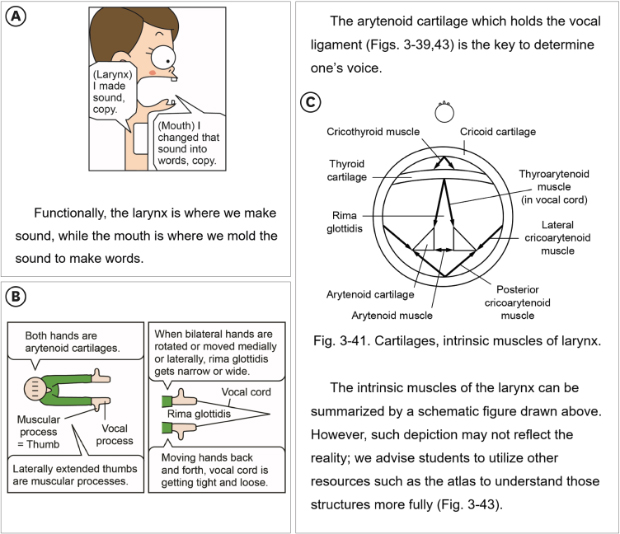1. Standring S. Gray's Anatomy. 41st ed. Philadelphia, PA: Churchill Livingstone;2016.
2. Drake RL, McBride JM, Lachman N, Pawlina W. Medical education in the anatomical sciences: the winds of change continue to blow. Anat Sci Educ. 2009; 2(6):253–259.


4. Entwistle NJ. Styles of Learning and Teaching: an Integrated Outline of Educational Psychology for Students, Teachers and Lecturers. London, UK: David Fulton Publishers;2013.
6. Miller SA, Perrotti W, Silverthorn DU, Dalley AF, Rarey KE. From college to clinic: reasoning over memorization is key for understanding anatomy. Anat Rec. 2002; 269(2):69–80.


7. Drake RL, Vogl AW, Mitchell AW. Gray's Anatomy for Students. 3rd ed. Philadelphia, PA: Churchill Livingstone Elsevier;2014.
8. Moore KL, Dalley AF, Agur AM. Clinically Oriented Anatomy. 7th ed. Baltimore, MD: Wolters Kluwer/Lippincott Williams & Wilkins;2014.
9. Park JS, Chung MS. Recording, editing, and distributing the movies of anatomy lectures. Korean J Anat. 2006; 39(1):17–25.
12. Goldberg S, Ouellette H. Clinical Anatomy Made Ridiculously Simple. 4th ed. Miami, FL: MedMaster Inc.;2012.
13. Drake R, Vogl AW, Mitchell AW. Dorland's/Gray's Pocket Atlas of Anatomy. Philadelphia, PA: Churchill Livingstone;2008.
14. Azman FN, Zaibon SB, Shiratuddin N. In : Zaman HB, Robinson P, Smeaton AF, Shih TK, Velastin S, Jaafar A, Ali NM, editors. Digital storytelling tool for education: an analysis of comic authoring environments. Advances in Visual Informatics: Proceedings of 4th International Visual Informatics Conference; Cham, Switzerland: Springer International Publishing;2015. p. 347–355.
15. Clavert P, Bouchaïb J, Duparc F, Kahn JL. A plea for the use of drawing in human anatomy teaching. Surg Radiol Anat. 2012; 34(8):787–789.


17. Kim J, Chung MS, Jang HG, Chung BS. The use of educational comics in learning anatomy among multiple student groups. Anat Sci Educ. 2017; 10(1):79–86.


18. Chung MS. Dr. Anatophil's Essay. Paju: Gimmyoung Publisher;2015.
19. Park JS, Kim DH, Chung MS. Anatomy comic strips. Anat Sci Educ. 2011; 4(5):275–279.

20. Federative Committee on Anatomical Terminology. Terminologia Anatomica: International Anatomical Terminology. Stuttgart, Germany: Thieme;1998.
24. Franklin T, Van Harmelen M. Web 2.0 for Content for Learning and Teaching in Higher Education. Bristol, UK: JISC;2007.
25. Si L, Callan J. In : Paques H, Liu L, Grossman D, Pu C, editors. A statistical model for scientific readability. Proceedings of the Tenth International Conference on Information and Knowledge Management; New York, NY; 2001. p. 574–576.
26. Levie WH, Lentz R. Effects of text illustrations: a review of research. Educ Technol Res Dev. 1982; 30(4):195–232.
27. Reid DJ. The role of pictures in learning biology: part 1, perception and observation. J Biol Educ. 1990; 24(3):161–172.

28. Reid DJ. The role of pictures in learning biology: part 2, picture-text processing. J Biol Educ. 1990; 24(4):251–258.

29. Harp SF, Mayer RE. The role of interest in learning from scientific text and illustrations: on the distinction between emotional interest and cognitive interest. J Educ Psychol. 1997; 89(1):92–102.

30. Williams RM. Image, text, and story: comics and graphic novels in the classroom. Art Educ. 2008; 61(6):13–19.

31. Jee BD, Anggoro FK. Comic cognition: exploring the potential cognitive impacts of science comics. J Cogn Educ Psychol. 2012; 11(2):196–208.

32. Green MJ. Teaching with comics: a course for fourth-year medical students. J Med Humanit. 2013; 34(4):471–476.


33. Goldenberg MD. Comics: a step toward the future of medicine and medical education? Ear Nose Throat J. 2016; 95(6):204–205.

34. Williams IC. Graphic medicine: comics as medical narrative. Med Humanit. 2012; 38(1):21–27.


36. Monk J. Go home, med student: comics as visual media for students' traumatic medical education experiences. AMA J Ethics. 2018; 20(1):141–147.

39. McLachlan JC. New path for teaching anatomy: living anatomy and medical imaging vs. dissection. Anat Rec B New Anat. 2004; 281(1):4–5.


40. Ainsworth S, Prain V, Tytler R. Science education. Drawing to learn in science. Science. 2011; 333(6046):1096–1097.

41. Van Meter P, Aleksic M, Schwartz A, Garner J. Learner-generated drawing as a strategy for learning from content area text. Contemp Educ Psychol. 2006; 31(2):142–166.

42. Wilson TD. Role of image and cognitive load in anatomical multimedia. In : Chan LK, Pawlina W, editors. Teaching Anatomy: a Practical Guide. New York, NY: Springer International Publishing;2015. p. 237–246.
43. Smith SR. Toward an integrated medical curriculum. Med Health R I. 2005; 88(8):258–261.

46. Johnson EO, Charchanti AV, Troupis TG. Modernization of an anatomy class: from conceptualization to implementation. A case for integrated multimodal-multidisciplinary teaching. Anat Sci Educ. 2012; 5(6):354–366.


47. Jaffar AA. YouTube: An emerging tool in anatomy education. Anat Sci Educ. 2012; 5(3):158–164.


48. Lewis TL, Burnett B, Tunstall RG, Abrahams PH. Complementing anatomy education using three-dimensional anatomy mobile software applications on tablet computers. Clin Anat. 2014; 27(3):313–320.


49. Chung BS, Park JS. Real-color volume models made from real-color sectioned images of Visible Korean. J Korean Med Sci. 2019; 34(10):e86.

50. McMenamin PG, Quayle MR, McHenry CR, Adams JW. The production of anatomical teaching resources using three-dimensional (3D) printing technology. Anat Sci Educ. 2014; 7(6):479–486.













 PDF
PDF Citation
Citation Print
Print





 XML Download
XML Download